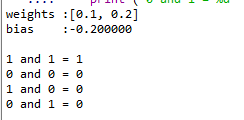Python3 采用面向对象实现感知器
面向对象编程的思想:https://blog.csdn.net/Andrew_jdw/article/details/82151275
将实现感知器任务划分成以下几个部分:
- 初始化感知器,包括权重和偏置项的初始化(设置激活函数以及输入参数的个数)
- 根据输入计算结果
- 根据计算的结果迭代更新权重和偏置项
- 输出最终结果
注:可以将第三步进行分解,将更新独立出来,再每次迭代进行更新。
class Perceptron(object):
def __init__(self, input_num, activator):
'''
初始化感知器,设置输入参数的个数,以及激活函数。
激活函数的类型为double -> double
'''
self.activator = activator
#初始化权重向量为0
self.weights = [0.0 for i in range(input_num)]
#偏置项设置初始化为0
self.bias = 0.0
def __str__(self):
'''
打印学习到的权重、偏置项(只要定义了该方法就会打印从这个方法中return的数据)
'''
return 'weights\t:%s\nbias\t:%f\n' % (self.weights, self.bias)
def predict(self, input_vec):
'''
输入向量,输出感知器的计算结果
'''
#加载reduce函数
from functools import reduce
# 把input_vec[x1,x2,x3...]和weights[w1,w2,w3,...]打包在一起
# 变成[(x1,w1),(x2,w2),(x3,w3),...]
zip_result = list(zip(input_vec, self.weights))
#计算[x1*w1, x2*w2, x3*w3]
multiply = [x*w for x,w in zip_result]
return self.activator(reduce(lambda x,y:x+y, multiply,self.bias))
def train(self, input_vecs, labels, iteration, rate):
'''
输入训练数据:一组向量、与每个向量对应的label;以及训练轮数、学习率
'''
for i in range(iteration):
self._one_iteration(input_vecs, labels, rate)
def _one_iteration(self, input_vecs, labels, rate):
'''
一次迭代,把所有的训练数据过一遍
'''
#把输入和输出打包在一起,成为样本的列表[(input_vec, label), ...]
#而每个训练样本是(input_vec, label)
samples = list(zip(input_vecs, labels))
#对每个样本,按照感知器规则更新权重
for (input_vec, label) in samples:
#计算出感知器在当前权重下的输出
output = self.predict(input_vec)
#更新权重
self._update_weights(input_vec, output, label, rate)
def _update_weights(self, input_vec, output, label, rate):
'''
根据感知器规则更新权重
'''
#误差
delta = label - output
# 把input_vec[x1,x2,x3,...]和weights[w1,w2,w3,...]打包在一起
# 变成[(x1,w1),(x2,w2),(x3,w3),...]
z = list(zip(input_vec, self.weights))
# 然后利用感知器规则更新权重
self.weights = [w + rate * delta * x for x,w in z]
#更新bias
self.bias += rate * delta
利用感知器实现and函数
def f(x):
'''
定义激活函数
'''
return 1 if x > 0 else 0
def get_training_dataset():
'''
基于and真值表构建训练数据
'''
input_vecs = [[1,1], [0,0], [1,0], [0,1]]
# 期望的输出列表,注意要与输入一一对应
# [1,1] -> 1, [0,0] -> 0, [1,0] -> 0, [0,1] -> 0
labels = [1, 0, 0, 0]
return input_vecs, labels
def train_and_perceptron():
p = Perceptron(2, f)
input_vecs, labels = get_training_dataset()
# 训练,迭代10轮, 学习速率为0.1
p.train(input_vecs, labels, 10, 0.1)
#返回训练好的感知器
return p
if __name__ == '__main__':
# 训练and感知器
and_perception = train_and_perceptron()
# 打印训练获得的权重
print(and_perception)
# 测试
print ('1 and 1 = %d' % and_perception.predict([1, 1]))
print ('0 and 0 = %d' % and_perception.predict([0, 0]))
print ('1 and 0 = %d' % and_perception.predict([1, 0]))
print ('0 and 1 = %d' % and_perception.predict([0, 1]))输出结果为:
参考链接:https://www.zybuluo.com/hanbingtao/note/433855
该链接中的实现方式是在Python2.7实现的,在此基础上进行部分修改,从而在Python3上实现
